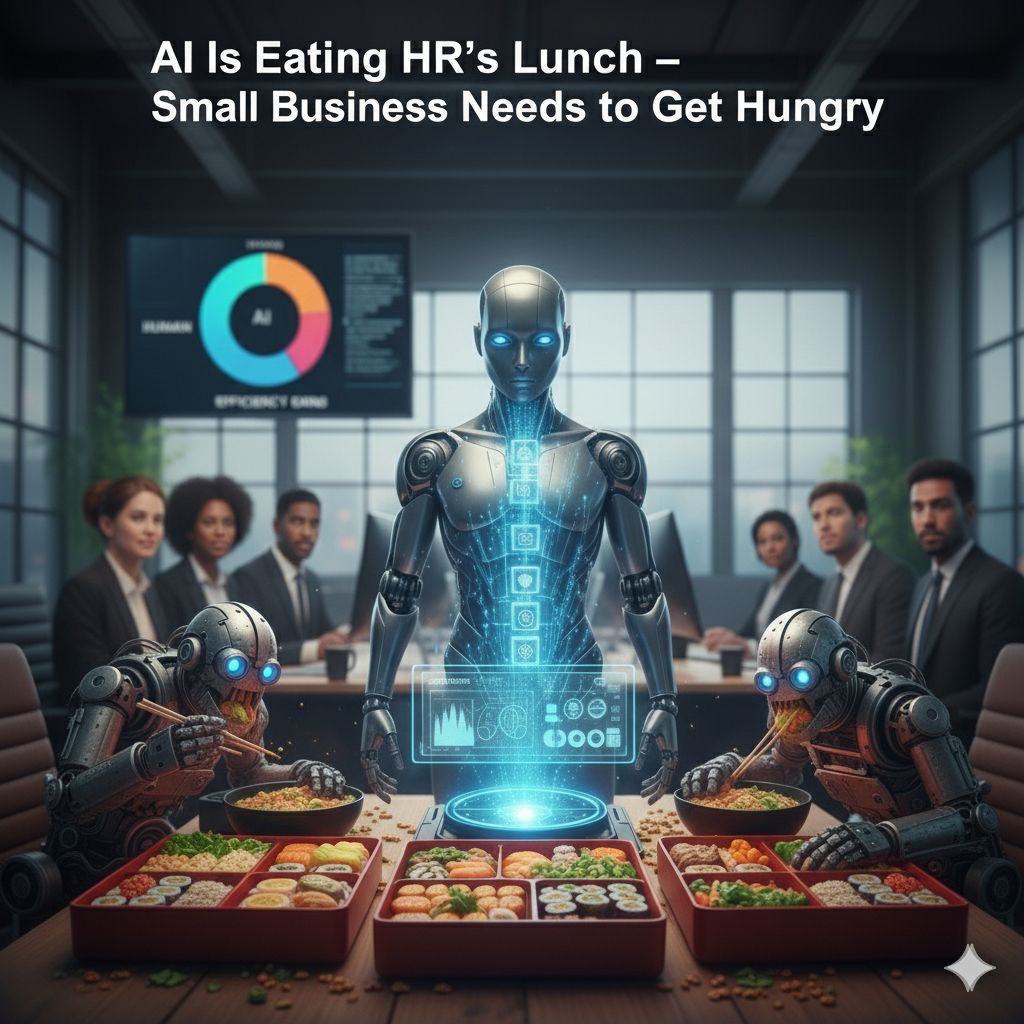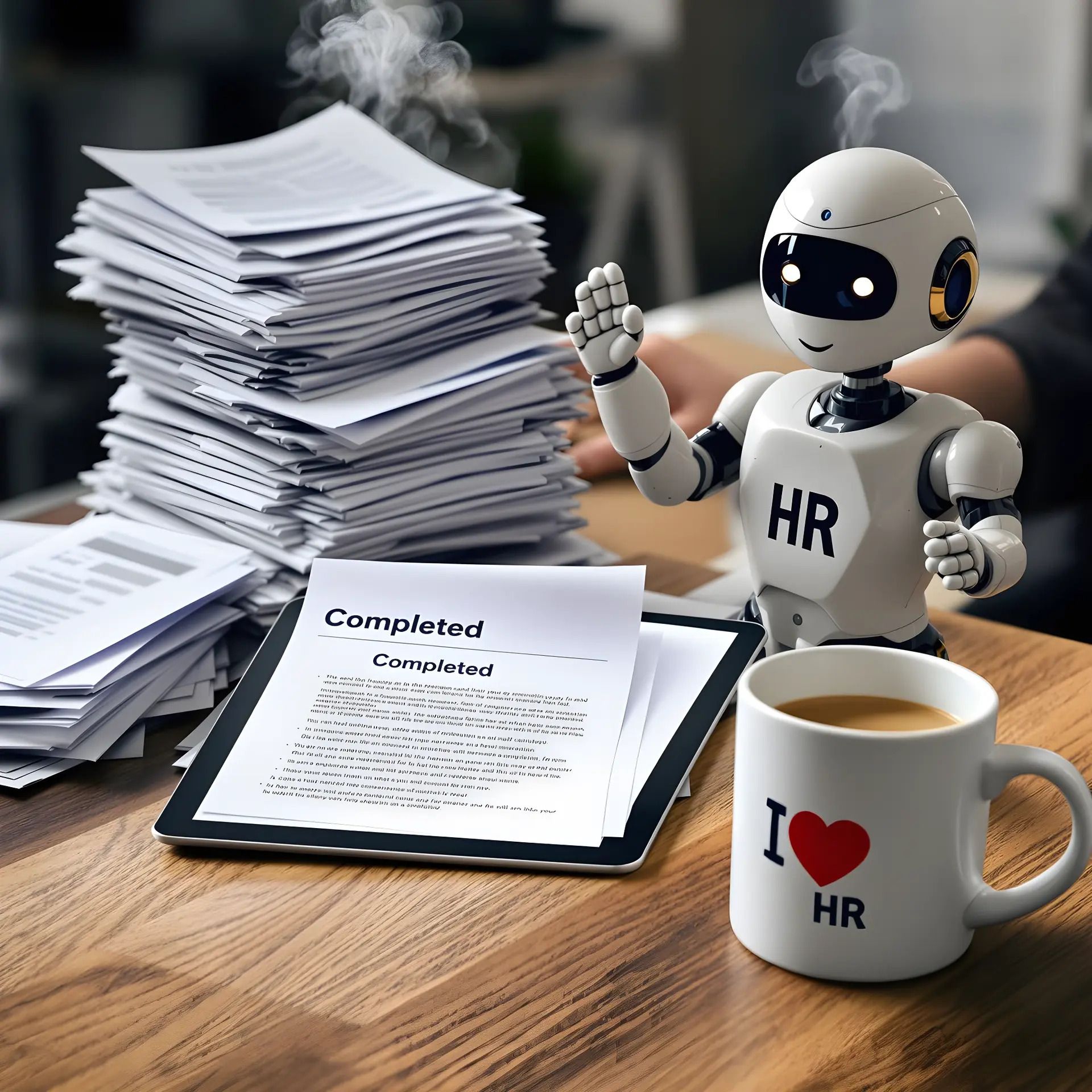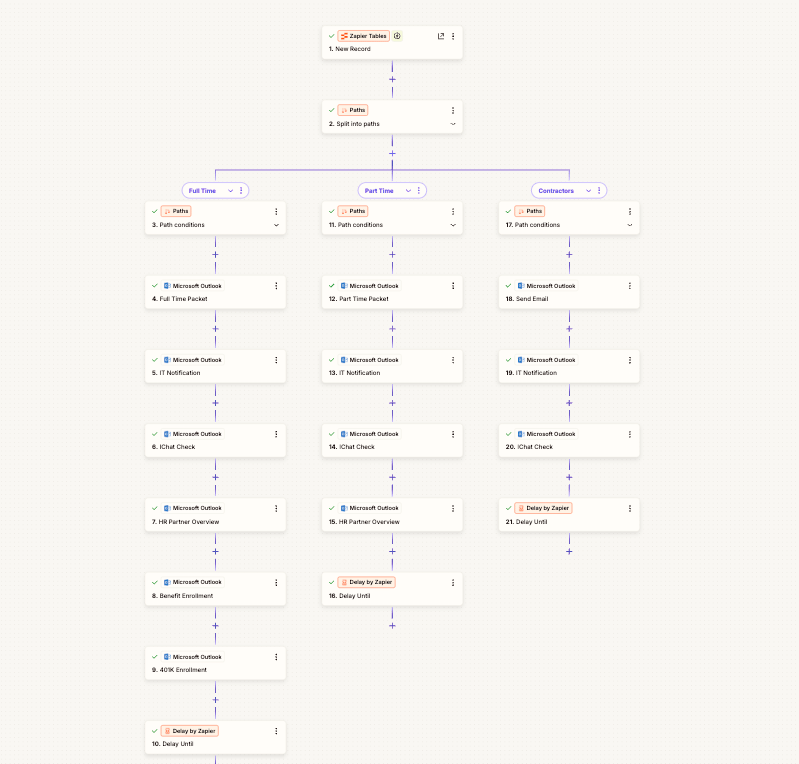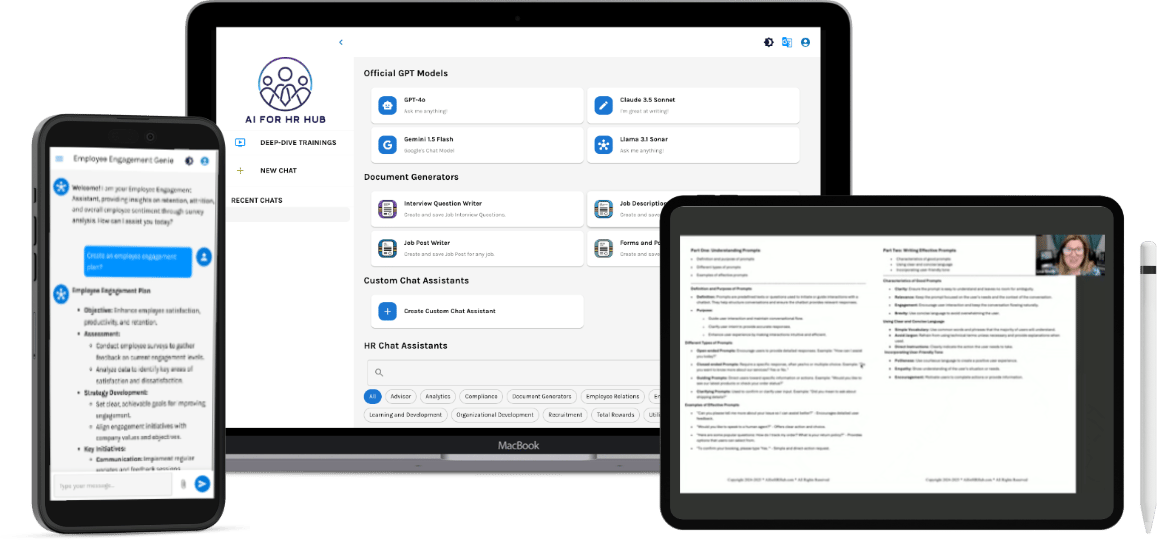- AI for HR Hub
- Posts
- AI for HR Hub Newsletter # 50 AI Is Eating HR’s Lunch – Small Business Needs to Get Hungry
AI for HR Hub Newsletter # 50 AI Is Eating HR’s Lunch – Small Business Needs to Get Hungry

Welcome to Your AI for HR Hub!
"Simplifying Your AI, One Boss-Move™ at a Time."
Today’s Insights and Helpful Hints
AI Is Eating HR’s Lunch – Small Business Needs to Get Hungry
5 AI Tools to Enhance Your Productivity
Prompt of the day: Writing HR data management policies
Fun with AI Images: AI in HR that makes onboarding paperwork effortless.
AI FOR HR NEWS
AI Is Eating HR’s Lunch – Small Business Needs to Get Hungry
Consolidation means AI recruiting is no longer a hobby
The last couple of years have shown a clear combine of HR tech tools. It looks like AI hiring is now a core skill any small firm can buy. In early 2025 Workday bought SAP SmartRecruiters. That made one platform with heavy analytics and a solid applicant tracker. The deal created two price plans. Big companies keep the “Enterprise AI” suite. A new “Growth” level caps a monthly fee at $49 and bundles résumé parsing, keyword pulls and interview bot scheduling.
That cheap price shows up in the numbers for Olivia, an AI recruiting chat bot that many use as a benchmark. In 2025 Olivia logged 189 million chats and turned about 70 % of them into interview invites (Olivia 2025). That shows a chat AI can keep a high flow while still being friendly to candidates.
A real life example is Chipotle. After adding an AI screening bot they cut their average time to hire from 12 days to 4 days, a 67 % drop. Faster hiring helped them open new stores quicker and cut turnover costs (Chipotle 2025).
Looking forward OpenAI says they will launch a hiring platform in mid 2026. The service is marketed as a “Google for tiny recruiters.” It will pull together résumé parsing, skill matching and interview scheduling in one low cost subscription for firms under 50 people. By mixing big language model power with a simple UI they want to make AI hiring something any mom and pop shop can afford.
All together these moves show AI recruiting left the lab bench and landed in a price sensitive market. For micro and small owners the moment is rare: strong tools are cheap, scalable and backed by big vendor networks.
Your next hire could be checked by AI – and that’s mostly good
The next wave is cultural: a push toward skills based hiring. In 2025 about 60-66 % of companies wrote job ads around skills, up from roughly 40 % five years earlier (SHRM 2025). This isn’t just talk. Vendors have built AI right into their communication and talent pipelines.
RingCentral teamed up with Findem to show the trend. Their joint product uses an AI skill extractor that cuts résumé reading time by 30 %, letting recruiters spend time on high value talks. T Mobile paired with Textio to add bias checking language models; after one quarter, applications from under represented groups rose 15 % (Textio 2025). IBM Watson rolled out across midsize retail chains and lifted hiring quality scores 22 %, measured by first year performance reviews (IBM 2025).
Academic work backs those numbers. Columbia Business School published a 2025 study that AI screening cut recruiter workload by 35 % and lifted interview success rates by 12 %. Stanford researchers reported AI bias mitigation lowered gender bias by 18 % and age bias by 22 %, without hurting predictive accuracy (Stanford 2025).
These data points line up: when used well, AI not only speeds hiring but also improves fairness. The tech can pull hidden talent, match people to role skills and free HR pros from paperwork so they can think strategically.
California rewrote the rule book
AI spread so fast that lawmakers stepped in, especially in California. The “No Robo Bosses” Act (SB 7) passed early 2025 and includes three bans on AI hiring:
AI cannot be the only decision maker.
AI must not look at protected traits such as race, gender, age, disability or income.
Employers must give a 30 day notice before letting AI screen a candidate.
The Civil Rights Council also says employers keep AI generated applicant data for four years for audit use.
Colorado copied the move with its AI Act, effective Feb 1 2026. The law forces clear disclosure of AI use and proof that no disparate impact exists. Companies under 10 workers get a loophole, but growing small firms need compliance now or face retro active liability.
Court rulings underscore seriousness. In Mobley v. Workday (July 2025) a judge said AI vendors can be jointly liable for discriminatory outcomes, rejecting the claim that outsourcing decision making wipes employer responsibility (Mobley 2025). That forces every hiring outfit, big or small, to treat AI as a regulated tool, not a plug and play service.
Bias is real, but can be tamed
People still worry about AI fairness. A Pew Research poll shows 47 % think AI favors older workers, 44 % say it hurts low income applicants and 30 % believe it disfavors the opposite gender. Because of that 66 % would stay away from employers that lean heavily on AI for recruitment (Pew 2025).
Still, evidence shows bias can be lowered without hurting results. Unilever worked with Pymetrics, processing 1.8 million applications, saving £1 million in manual review and cutting 70 000 hours of work. Diversity hires grew from 22 % to 31 %, a 41 % jump thanks to AI driven blind assessments (Unilever 2025).
Tiny firms without huge compliance teams can take practical steps:
Hire an outside auditor (cost $10 k-$50 k) to test algorithmic fairness and log any disparate impact.
Keep a human in the loop for every AI generated shortlist before final hires, so context isn’t lost.
Demand that vendors give bias dashboards, model docs and an instant “switch off” clause if illegal factors are found.
Those modest moves match SB 7 and Colorado’s rules and also boost the company’s brand with candidates who fear hidden automation.
A three month action plan
A Paychex poll says 65 % of small owners already use some AI in hiring, and 61 % chat with those tools every day (Paychex 2025). To turn that early use into a lasting, compliant edge, firms should follow a three month rollout that mixes quick tests with hard governance.
October 2025 – Audit & Map
List every AI tool used for recruiting, onboarding and performance.
Compare each tool to SB 7, the four year retention rule and Colorado’s AI Act; flag gaps.
Ask vendors for proof of bias removal, data retention policies and recent audit reports.
Goal: Have a compliance matrix covering 100 % of tools and find at least two needing fixes.
Nov Dec 2025 – Pilot & Governance
Pick a high impact use case, like AI résumé parsing for entry level jobs, and test on 20 % of new applicants.
Insert a human reviewer for each AI made shortlist; build a 30 day notice template for candidates.
Train hiring managers on reading AI scores, spotting bias signs and documenting why they pick someone.
Goal: Cut screening time >30 %, grow qualified candidate pool >10 %, and have zero compliance breaches during pilot.
Q1 2026 – Review & Scale
Compare pilot results to targets; bring in an external auditor for a formal bias test.
Update vendor contracts with clear compliance clauses, penalties for breaking SB 7 or Colorado rules.
Roll the vetted AI tool out company wide; set quarterly audits and a feedback loop for improvement.
Goal: Lower overall hiring cost ≥25 %, raise diverse hires ≥15 %, keep full statutory compliance everywhere.
Following this timeline lets small businesses grab AI speed while staying safe from legal risk and brand damage.
Verdict: act now, but act wise
Adoption trends are crystal clear. HR leaders using generative AI rose from 19 % in 2023 to 61 % in 2025 (SHRM 2025). Gartner predicts 37 % of workers will feel a “real AI impact” in the next 2-5 years (Gartner 2025). September 2025 is a strategic turning point: market consolidation gave cheap, enterprise grade tools; research backs AI’s efficiency and bias fixing power; and state laws set a clear compliance line.
Firms that move now, using the disciplined three month plan, will lock in a sustainable talent edge, see clear cost cuts and prove a commitment to fair hiring. Those that wait risk long gaps on jobs, higher recruiting spend and costly lawsuits under SB 7 or Colorado’s AI Act.
In plain terms, AI has already “eaten HR’s lunch”; small biz owners must become hungry for AI, but must serve it with strong governance, regular audits and vigilant legal oversight. The days of pricey, exclusive AI recruiting are over. The era of affordable, inclusive and responsibly run AI hiring has arrived.
AI Tools to Enhance Your Productivity or Have Fun
Napkin: → transforms your written text into editable visuals (like diagrams, charts, and infographics) to help communicate ideas more effectively.
Capalyze: Collect data, analyze it, and generate reports with an AI agent.
Wan 2.5: Transform text prompts into professional HD videos.
Koke: Instantly create citations in APA, MLA, Chicago, IEEE, Harvard, and more formats.
BestPDF: Edit, convert, and manage PDF online with AI.
AI for HR Hub Deep Dive Training
Plan, build and launch a custom onboarding automation.
Customize workflows for roles and departments
Apply AI to onboarding, engagement, and performance insights Monitor, troubleshoot, and measure automation performance.
Get started for $399
PROMPT OF THE DAY
Writing HR data management policies
Prompt: I need help creating a policy that ensures compliance with data protection laws such as {{specific data protection laws/regulations}}, as they apply to {{specific data types/locations}}. Can you provide me with some language and guidance on how to implement such policies, and how to {{specifically monitor/enforce}} compliance within our organization?AI for HR Hub empowers you with powerful tools and 40-plus pre-trained assistants to manage every aspect of HR. Explore features like automated policy creation, employee engagement insights, and much more.
Access ChatGPT, Claude, Llama, and Gemini in one place
Translate virtually any language
Build custom AI assistants
Streamline compliance and documentation processes
FUN WITH AI IMAGES
AI in HR that makes onboarding paperwork effortless.

Prompt: A messy stack of forms transforming into one clean digital document on a tablet stamped 'Completed', a friendly robot waving, and a steaming white coffee mug labeled 'I heart HR' on the table." PARTNER WITH US!
AI for HR Hub always seeks ways to partner with vendors serving the human resources community. Contact us, and let’s chat about the possibilities! [email protected]
Don’t get SaaD. Get Rippling.
Software sprawl is draining your team’s time, money, and sanity. Our State of Software Sprawl report exposes the true cost of “Software as a Disservice” and why unified systems are the future.
❓ What did you think about today's newsletter?Be honest! Your feedback means everything to out team. |
Thanks for reading!
Until next time,
AI for HR Hub™ Team

Some links may be affiliate links. If you purchase through them, we may earn a commission at no cost to you.
Disclaimer
Please review and use the information provided at your own discretion. The content presented here is for informational purposes only and should not be construed as legal advice. Users are advised to:
Carefully evaluate all information before application
Consult with appropriate professionals or experts when necessary
Understand that circumstances may vary, and what works in one situation may not be suitable for another
The authors and distributors of this information cannot be held responsible for any consequences resulting from its use. By proceeding, you acknowledge that you have read and understood this disclaimer.




